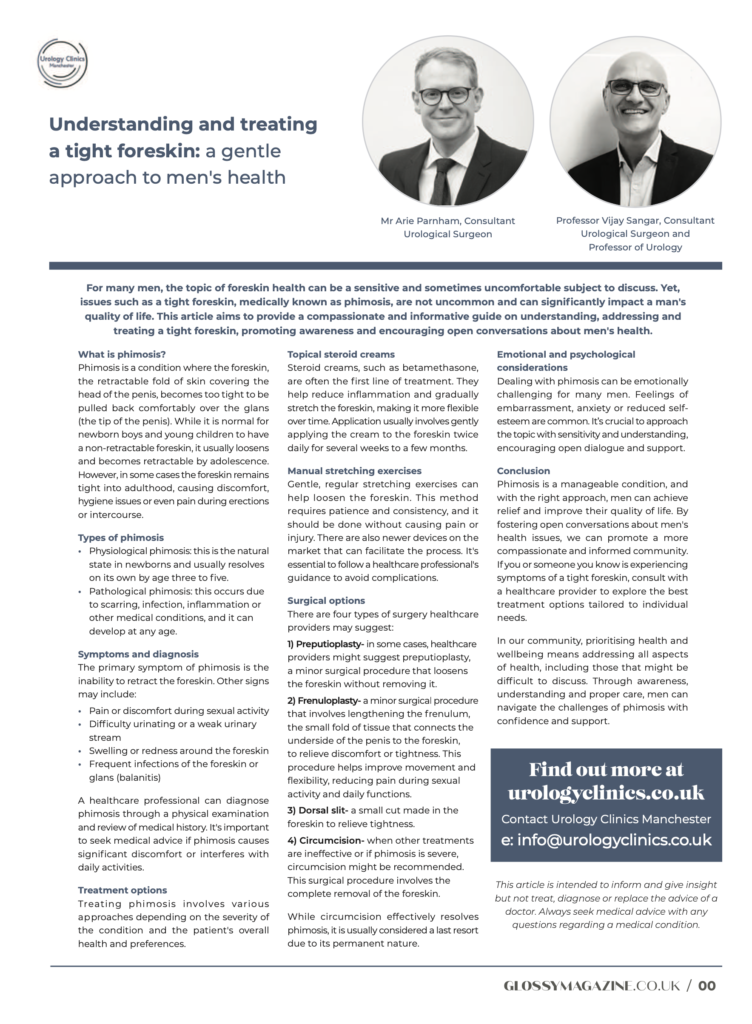
Understanding and treating a tight foreskin: a gentle approach to men’s health.
For many men, the topic of foreskin health can be a sensitive and sometimes uncomfortable subject to discuss. Yet, issues such as a tight foreskin, medically known as phimosis, are not uncommon and can significantly impact a man’s quality of life. This article aims to provide a compassionate and informative guide on understanding, addressing and treating a tight foreskin, promoting awareness and encouraging open conversations about men’s health.
What is phimosis?
Phimosis is a condition where the foreskin, the retractable fold of skin covering the head of the penis, becomes too tight to be pulled back comfortably over the glans (the tip of the penis). While it is normal for newborn boys and young children to have a non-retractable foreskin, it usually loosens and becomes retractable by adolescence.
However, in some cases the foreskin remains tight into adulthood, causing discomfort, hygiene issues or even pain during erections or intercourse.
Types of phimosis
• Physiological phimosis: this is the natural state in newborns and usually resolves on its own by age three to five.
• Pathological phimosis: this occurs due to scarring, infection, inflammation or other medical conditions, and it can develop at any age.
Symptoms and diagnosis
The primary symptom of phimosis is the inability to retract the foreskin.
Other signs may include:
• Pain or discomfort during sexual activity
• Difficulty urinating or a weak urinary stream
• Swelling or redness around the foreskin
• Frequent infections of the foreskin or glans (balanitis)
A healthcare professional can diagnose phimosis through a physical examination and review of medical history. It’s important to seek medical advice if phimosis causes significant discomfort or interferes with daily activities.
Treatment options
Treating phimosis involves various approaches depending on the severity of the condition and the patient’s overall health and preferences.
Topical steroid creams – Steroid creams, such as betamethasone, are often the first line of treatment. They help reduce inflammation and gradually stretch the foreskin, making it more flexible over time. Application usually involves gently applying the cream to the foreskin twice daily for several weeks to a few months.
Manual stretching exercises – Gentle, regular stretching exercises can help loosen the foreskin. This method requires patience and consistency, and it should be done without causing pain or injury. There are also newer devices on the market that can facilitate the process. It’s essential to follow a healthcare professional’s guidance to avoid complications.
Surgical options – There are four types of surgery healthcare providers may suggest:
1) Preputioplasty- in some cases, healthcare providers might suggest preputioplasty, a minor surgical procedure that loosens the foreskin without removing it.
2) Frenuloplasty- a minor surgical procedure that involves lengthening the frenulum, the small fold of tissue that connects the underside of the penis to the foreskin, to relieve discomfort or tightness. This procedure helps improve movement and flexibility, reducing pain during sexual activity and daily functions.
3) Dorsal slit- a small cut made in the foreskin to relieve tightness.
4) Circumcision- when other treatments are ineffective or if phimosis is severe, circumcision might be recommended. This surgical procedure involves the complete removal of the foreskin.
While circumcision effectively resolves phimosis, it is usually considered a last resort due to its permanent nature.
Emotional and psychological considerations
Dealing with phimosis can be emotionally challenging for many men. Feelings of embarrassment, anxiety or reduced self-esteem are common. It’s crucial to approach the topic with sensitivity and understanding, encouraging open dialogue and support.
Conclusion
Phimosis is a manageable condition, and with the right approach, men can achieve relief and improve their quality of life. By fostering open conversations about men’s health issues, we can promote a more compassionate and informed community.
If you or someone you know is experiencing symptoms of a tight foreskin, consult with a healthcare provider to explore the best treatment options tailored to individual needs.
Contact the team at Urology Clinics Manchester to book your consultation here.





0 Comments